Intel Core i7 4960X (Ivy Bridge E) Review
by Anand Lal Shimpi on September 3, 2013 4:10 AM EST- Posted in
- CPUs
- Intel
- Ivy Bridge
- Ivy Bridge-E
Gaming Performance
Chances are that any gamer looking at an IVB-E system is also considering a pretty ridiculous GPU setup. NVIDIA sent along a pair of GeForce GTX Titan GPUs, totalling over 14 billion GPU transistors, to pair with the 4960X to help evaluate its gaming performance. I ran the pair through a bunch of games, all at 1080p and at relatively high settings. In some cases you'll see very obvious GPU limitations, while in other situations we'll see some separation between the CPUs.
I haven't yet integrated this data into Bench, so you'll see a different selection of CPUs here than we've used elsewhere. All of the primary candidates are well represented here. There's Ivy Bridge E and Sandy Bridge E of course, in addition to mainstread IVB/SNB. I threw in Gulftown and Nehalem based parts, as well as AMD's latest Vishera SKUs and an old 6-core Phentom II X6.
Bioshock Infinite
Bioshock Infinite is Irrational Games’ latest entry in the Bioshock franchise. Though it’s based on Unreal Engine 3 – making it our obligatory UE3 game – Irrational had added a number of effects that make the game rather GPU-intensive on its highest settings. As an added bonus it includes a built-in benchmark composed of several scenes, a rarity for UE3 engine games, so we can easily get a good representation of what Bioshock’s performance is like.
We're running the benchmark mode at its highest quality defaults (Ultra DX11) with DDOF enabled.
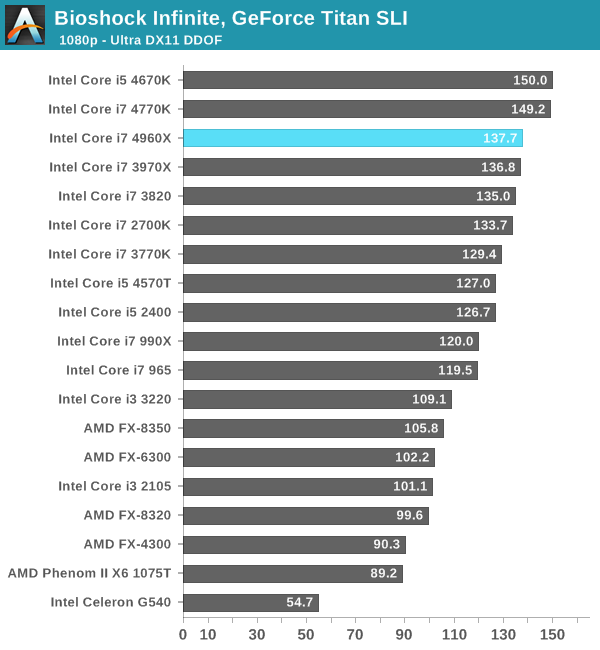
We're going to see a lot of this I suspect. Whenever we see CPU dependency in games, it tends to manifest as being very dependent on single threaded performance. Here Haswell's architectural advantages are appearent as the two quad-core Haswell parts pull ahead of the 4960X by about 8%. The 4960X does reasonably well but you don't really want to spend $1000 on a CPU just for it to come in 3rd I suppose. With two GPUs, the PCIe lane advantage isn't good for much.
Metro: Last Light
Metro: Last Light is the latest entry in the Metro series of post-apocalyptic shooters by developer 4A Games. Like its processor, Last Light is a game that sets a high bar for visual quality, and at its highest settings an equally high bar for system requirements thanks to its advanced lighting system. We run Metro: LL at its highest quality settings, tesselation set to very high and with 16X AF/SSAA enabled.
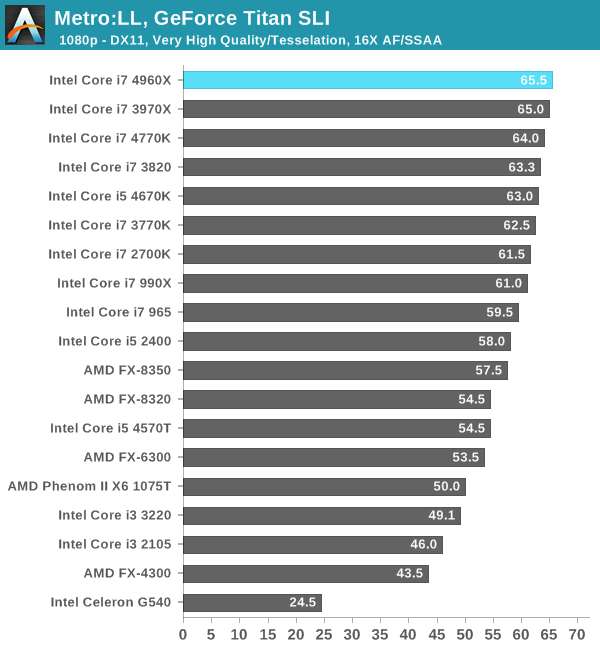
The tune shifts a bit with Metro: LL. Here the 4960X actually pulls ahead by a very small amount. In fact, both of the LGA-2011 6-core parts manage very small leads over Haswell here. The differences are small enough to basically be within the margin of error for this benchmark though.
Sleeping Dogs
A Square Enix game, Sleeping Dogs is one of the few open world games to be released with any kind of benchmark, giving us a unique opportunity to benchmark an open world game. Like most console ports, Sleeping Dogs’ base assets are not extremely demanding, but it makes up for it with its interesting anti-aliasing implementation, a mix of FXAA and SSAA that at its highest settings does an impeccable job of removing jaggies. However by effectively rendering the game world multiple times over, it can also require a very powerful video card to drive these high AA modes.
Our test here is run at the game's Extreme Quality defaults.
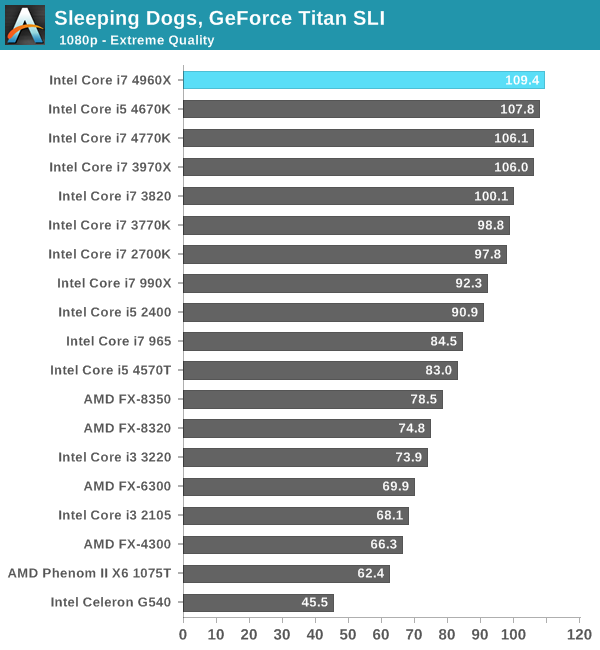
Sleeping Dogs shows similar behavior of the 4960X making its way to the very top, with Haswell hot on its heels.
Tomb Raider (2013)
The simply titled Tomb Raider is the latest entry in the Tomb Raider franchise, making a clean break from past titles in plot, gameplay, and technology. Tomb Raider games have traditionally been technical marvels and the 2013 iteration is no different. Like all of the other titles here, we ran Tomb Raider at its highest quality (Ultimate) settings. Motion Blur and Screen Effects options were both checked.
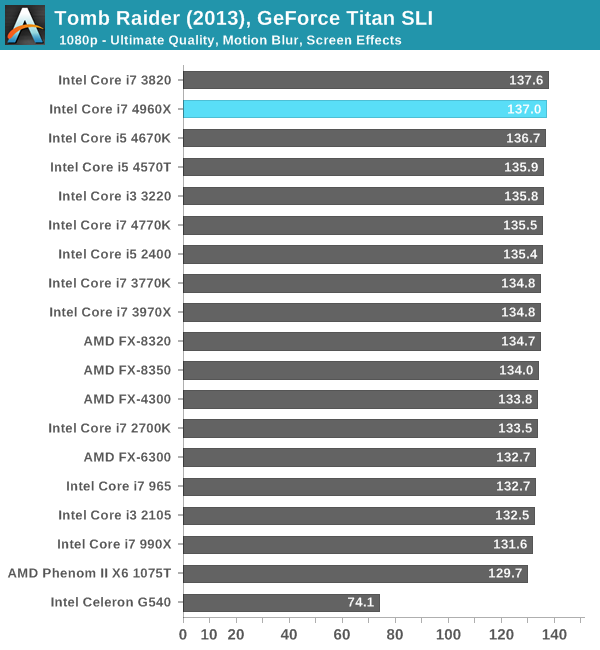
With the exception of the Celeron G540, nearly all of the parts here perform the same. The G540 doesn't do well in any of our tests, I confirmed SLI was operational in all cases but its performance was just abysmal regardless.
Total War: Shogun 2
Our next benchmark is Shogun 2, which is a continuing favorite to our benchmark suite. Total War: Shogun 2 is the latest installment of the long-running Total War series of turn based strategy games, and alongside Civilization V is notable for just how many units it can put on a screen at once. Even 2 years after its release it’s still a very punishing game at its highest settings due to the amount of shading and memory those units require.
We ran Shogun 2 in its DX11 High Quality benchmark mode.
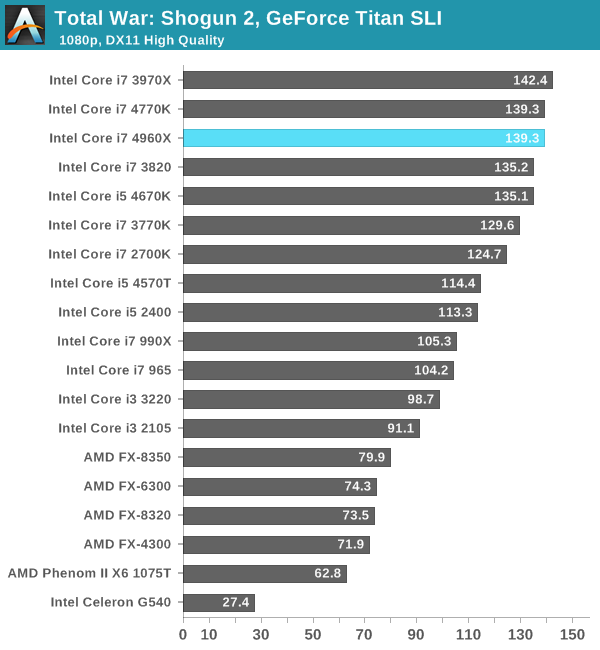
We see roughly equal performance between IVB-E and Haswell here.
GRID 2
GRID 2 is a new addition to our suite and our new racing game of choice, being the very latest racing game out of genre specialty developer Codemasters. Intel did a lot of publicized work with the developer on this title creating a high performance implementation of Order Independent Transparency for Haswell, so I expect it to be well optimized for Intel architectures.
We ran GRID 2 at Ultra quality defaults.
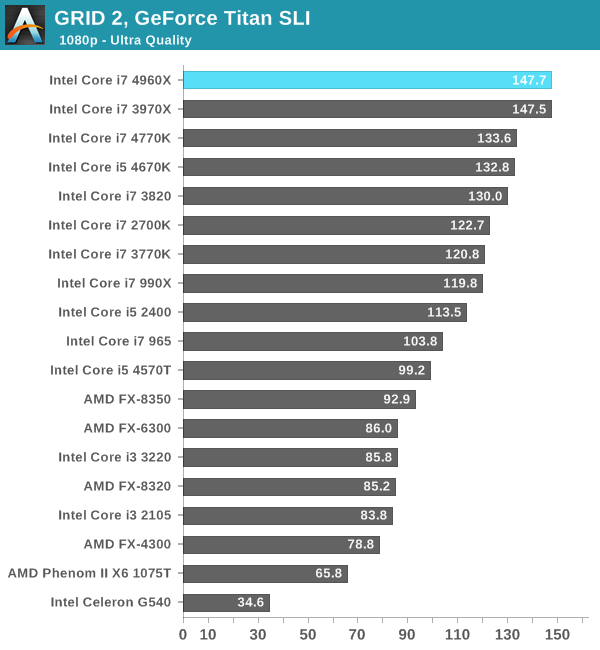
We started with a scenario where Haswell beat out IVB-E, and we're ending with the exact opposite. Here the 10% advantage is likely due to the much larger L3 cache present on both IVB-E and SNB-E. Overall you'll get great gaming performance out of the 4960X, but even with two Titans at its disposal you won't see substantially better frame rates than a 4770K in most cases.










120 Comments
View All Comments
chadwilson - Tuesday, September 3, 2013 - link
Is the IHS soldered or using the cheap termal material? The issue with desktop IB & Haswell overclockability has been proven to be the cheap thermal material between the chip and IHS. If they have a soldered chip to IHS then this will be a decent upgrade over straight IB.BrightCandle - Tuesday, September 3, 2013 - link
Considering the power consumption, clock speed, overclock and temperature obtained its looking most like this is the same interface as SB-E - ie its soldered. Not that it makes much difference as just like SB-E it doesn't actually overclock all that well compared to its 4 core sibling.MrSpadge - Tuesday, September 3, 2013 - link
Look at the results: temperature is not the main problem any more due to the bigger die, but OC is still not good at 4.3 GHz / 1.4 V. Actually I'd say this is ridiculously bad compared to earlier 22 nm chips (my Ivy can do this at ~1.1 V).And I recently got a 3770K which requires 1.11 V to even hit 4.0 GHz! Seems to me Intels current process is to blame for Haswell OC rather than the thermal paste. Sure, temps drop when replacing the paste.. but OC doesn't improve all that much, does it? And if Ivy and Ivy-E don't clock all that well either...
Shadowmaster625 - Tuesday, September 3, 2013 - link
If SNB-E @ 435 mm^2 fit into 130W then they could have made IVB-E @ 435 mm^2 fit into about the same power envelope. If they had to drop the clocks a couple hundred MHz then that's a small price to pay for 10 cores.Kevin G - Wednesday, September 4, 2013 - link
Actually, the core count for the larger Ivy Bridge-E goes up to 12.adamantinepiggy - Tuesday, September 3, 2013 - link
So do these CPU use actual solder under the lid or crappy paste like the 4770K?noeldillabough - Tuesday, September 3, 2013 - link
Oh I've waiting for this! Now the most important question to me...which motherboard is everyone getting an Ivy Bridge-E going to use? I'm doing a custom water cooled loop if that makes any difference.diceman2037 - Tuesday, September 3, 2013 - link
Anand, that marketing image is suffering from a typo, "18% Lower" refers to power utilized, not performance.DMCalloway - Tuesday, September 3, 2013 - link
Wow! 40 PCIe lanes sounds great until you remember skt. 2011 still only supports two 'true' sata3 ports and no native usb3. PCIe storage is never a smooth experience. It's a shame Intel seems unconcerned with power users that are not enterprised based.randfee - Tuesday, September 3, 2013 - link
What a shame these don't support ECC memory! I want it back for the enthusiast!I'm a scientist, what am I supposed to purchase (privately)? I want a beefy machine for physics simulations at home that run for days/weeks i.e. What if a privat person wants to run several VMs?
The E-series would provide nice performance, but no ECC, what a shame!
Right now one has to pick between speed without ECC (chances are the crashes on you) or a chip with relatively slow performance (clock wise) to get ECC, at the same price point. The highend XEON CPUs are out of the question.
@ Anand, please point out to the Intel representatives you meet that there's a market for this! One has to consider AMD at this point, they offer many threads + ECC for a consumer price point. Granted, they're slower, but the premium for the Intel chips with ECC is just out of proportion for private use.